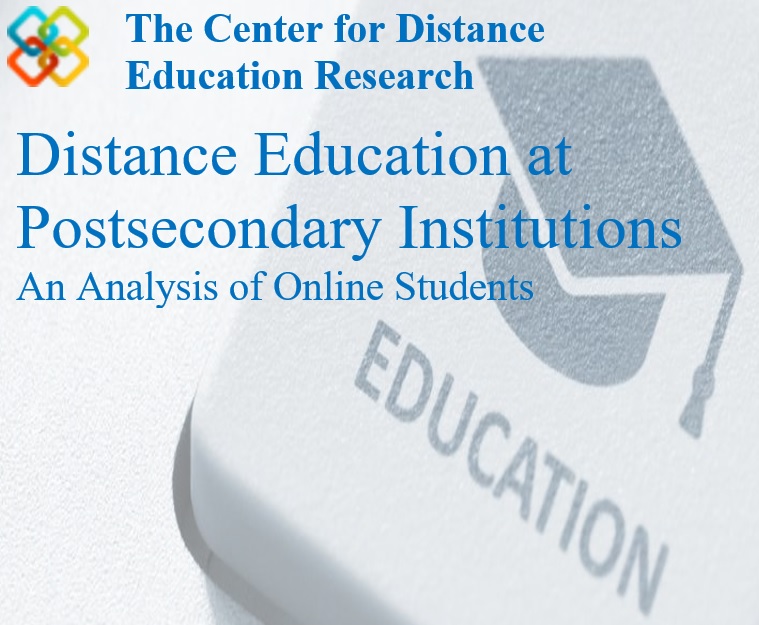
Annually, all institutions that participate in any federal assistance program authorized by Title IV of the Higher Education Act are mandated to submit required data through the IPEDS surveys. As part of this annual data collection, institutions are required to report on the number of students enrolled in exclusively distance education courses and students enrolled in some but not all distance education courses, in addition to enrollments in non-distance education courses.
To the general public, some colleges appear to be completely online and deliver all their courses online, but in their reporting of data to IPEDS they are not. In order to isolate “online colleges”, this report utilized the data point of exclusively distance education course enrollments from the fall 2017 enrollment survey. IPEDS (2017) defines a distance education course as “a course in which the instructional content is delivered exclusively via distance education. Requirements for coming to campus for orientation, testing, or academic support services do not exclude a course from being classified as distance education”. To qualify as an online college, in this report, an institution had to report the exact enrollment count for all student enrollments and for exclusively distance education enrollments.
The results, 67 colleges had 100% of the institution’s enrollments delivered exclusively through distance education in fall 2017.
The purpose of this report is to analyze and synthesize a population of institutions, commonly referred to as “online colleges”, in order to reflect a comprehensive description of the student who is enrolling.
Distance Education Students: A Profile of 67 Online Colleges
By comparing exclusively distance education enrollments to overall enrollments at each degree granting institution in fall 2017, there were 67 institutions where overall enrollments matched exclusively distance education enrollments 100%. These 67 institutions enrolled 452,004 students in exclusively distance education courses and are referred to as online colleges for the remainder of this report.
Figure 6. Count of online colleges by institution sector

These online colleges resided in 27 different states, with California (n=10), Indiana (n=6), Florida (n=5), Arizona (n=5), and Colorado (n=4) rounding out the top five and being the home state to 45% of the online colleges. Adding in Alabama, West Virginia, Utah and Wisconsin, each with three online colleges, these nine states were home to 63% of the online colleges.
Most online college students were enrolled at private for-profit institutions (265,802, 59%), followed by private not-for-profit institutions (154,600, 34%), and then public institutions (31,602, 7%). Enrollment distribution in online colleges are the opposite of national numbers, where 52% of exclusively distance education course enrollments were at public institutions, followed by private not-for-profit at 25%, and private for-profit at 23%.
Summary
Very little information is known about the 3,131,781 students who enrolled in exclusively distance education courses in fall 2017, outside of internal institutional data. Utilizing the freely available IPEDS data sets, this analysis found 67 online colleges that enrolled 452,004 students only in exclusively distance education courses. This student population is roughly 14% of all exclusively distance education enrollments.
The purpose of this report was to analyze and synthesize a population of institutions, commonly referred to as “online colleges”, in order to reflect a comprehensive description of the student who is enrolling. While there are more data points to be considered this report specifically analyzed gender, race and ethnicity, and age with regards to enrollment and completions. The data analysis resulted in several key takeaways:
- Sixty-seven online colleges enrolled 452,004 students in exclusively distance education courses, roughly 14% of all exclusively distance education enrollments
- Private for-profit, 4-year institutions (n=32) enrolled the most students with 265,802
- Sixty-three percent of online college enrollments were at the undergraduate level
- Online college students were primarily out of state students, 88%; enrolled part-time, 46% undergraduate and 50% graduate; and largely female, 63%
- African American students were represented more in online colleges, 21% compared to 12% at all degree-granting institutions
- Hispanic students were less represented at online colleges, 9% compared to 18% at all degree-granting institutions
- Online college students were older; 86% of undergraduates and 97% of graduates were over the age of 25
- Females comprised most conferrals at 63% but also the most advanced degrees with 68% of master’s degrees 67% of doctoral research/scholarship degrees